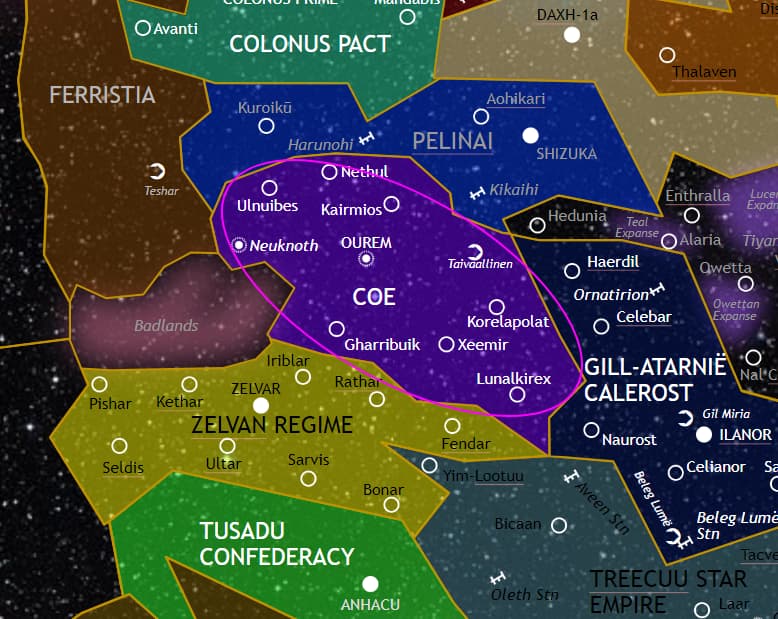Back in my day we just did it…
Anyways, right now I’ll calculate what the Galactyan Empire’s total star count would be if it was more three-dimensional (imagine a sort of elongated bubble)
Based on the results we could base the star count per plot off of that if you people want
I’ll get back to you with the results asap
@Maverick @Qwert (tagging you two since you’re the main reference points I currently have, sorry about that)
I approximated the Galactyan Plot to an ellipse, so that I could figure out it’s volume more easily.
(Ignore the COE name, I used my personal sandbox)
The Ellipse would have a total volume of approximately 14.000.000 cubic lightyears, and it would contain approximately 56000 stars.
Mhhh, I dunno. To be completely honest, my plot is one of the smallest ones in the Sector so it’s probably not the best idea to base everything off of that. At least, I think we should try and see the results for some other plots.
Between all of them, which plot/plots do you think is/are in the middle in terms of size? It’s probably best to base our definitive numbers off of that/those.
An easy one to do would be Rehy
Yeah, good idea, I should probably that one
Seems relatively average
Rehy seems indeed average & Colestia (including the Ventarian Empire) seems to be among the largest ones that’s easy to estimate.
For reference, which stellar density did you use for this? Also based on how many sector stars? 59,840,000?
Calculating the maximum Treecuu plot space I get 146.9 million ly^3. This number is valid for alternative 2 above where we don’t enlarge plots to fit the sector. With a stellar density of 0.004 I get roughly a maximum of 588,000 stars.
The stellar density I used is 0.004 stars per cubic lightyear.
Yeah, in fact I just made the Galactyan volume a bit more realistic in shape by making it an ellipsoid. Obviously, plots that are smaller in size on the map can be more developed in height to achieve the same number of stars as the plots that are larger on the map
Okay so, if Rehy was a sphere 233 light years in radius, it would have a total volume of 52.985.400 cubic lightyears. With a stellar density of 0.004, it would contain a total of 211942 stars.
The entire sector has a volume of roughly 15.9 billion ly^3 and a potential 63.5 million stars (stellar density 0.004 stars/ly^3). (The Treecuu plot would be almost 1% of the total sector volume using alternative 2.)
The plot areas are easily obtained from Inkscape. If we were to list them, players could chose a plot height of up to 1000 ly and calculate the number of stars using a stellar density of 0.003-0.004 stars/ly^3 maybe?
Yeah, that could definitely work. Should we also come up with a maximum amount of stars per plot, or can we just give roleplayers total freedom?
I feel like giving a maximum would still be necessary
You get the maximum amount by multiplying the plot surface area with the maximum height of 1000 ly and the maximum stellar density of 0.004 stars/ly^3.
Or do you mean they should be listed along with the plot surface areas?
Yeah maybe list them so we don’t have any loose ends. What about the number of planets/worlds though?
At this point we can just multiply the number of stars per 1.6. It wouldn’t make sense to make so many stars available, but also anomalously limit planets so much.
Certain civilizations may make more use of planets than stars, and vice versa. So it would not be unbalanced (at least in my opinion)
We can adjust the number of habitable worlds and number of communicative civilisations by tweaking the variables for the Drake’s equation so that we don’t need to throw out all our old numbers.
Arguably, habitable worlds could remain the same as now, or at least similar. The total amount of planets though would depend on the number of stars a plot has.

